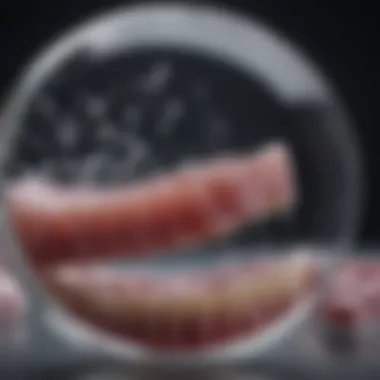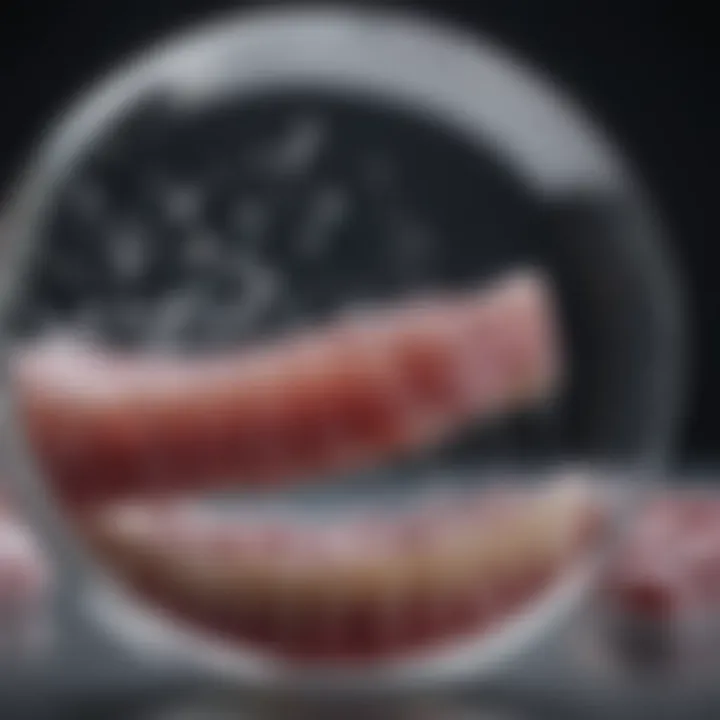Oral Dissolving Film Formulation: An In-Depth Study


Intro
Oral dissolving films (ODFs) represent a modern approach to drug delivery, providing a means of administration that is not only effective but also convenient. The significance of ODFs lies in their ability to dissolve quickly in the oral cavity, offering rapid absorption and onset of action. This has made them an attractive option for both patients and healthcare providers. In order to understand ODFs fully, it is important to explore their formulation and the various factors contributing to their success. This article aims to provide an in-depth analysis of the components, manufacturing processes, and regulatory frameworks associated with ODFs, elucidating the challenges and potential future advancements in this field.
Article Overview
Summary of Key Findings
Through rigorous exploration, certain key findings emerge regarding the formulation of ODFs. The choice of polymers plays a critical role in film formation and stability. Polyvinyl alcohol and hydroxypropyl methylcellulose are some widely used polymers that affect the film's mechanical properties and dissolution time. Additionally, plasticizers such as glycerin and sorbitol are often incorporated to enhance flexibility and prevent brittleness. Active pharmaceutical ingredients must also be carefully selected, as they need to be compatible with the other components and should possess suitable solubility profiles.
Research Objectives
The primary objective of this examination is to provide a comprehensive resource for researchers and professionals in the pharmaceutical technology domain. Specific goals include:
- Identifying key formulation components and their interactions.
- Detailing manufacturing processes to guide effective production.
- Analyzing regulatory considerations essential for development and market approval.
- Discussing challenges faced in ODF formulation and possible future directions for innovation.
Key Results and Discussions
Main Findings
One of the most notable findings in ODF formulation is the importance of balancing the properties of the film. The mechanical strength, thickness, and permeability are all influenced by the selection of polymers and the ratios used. Various studies indicate that the incorporation of plasticizers can significantly lower the glass transition temperature, resulting in a more pliable film that retains its structural integrity during handling.
Another crucial aspect is the compatibility of the active pharmaceutical ingredients with the film matrix. Research demonstrates that certain drugs may require specific formulations to ensure optimal release kinetics, highlighting the need for tailored approaches depending on the therapeutic agent and desired release profile.
Implications of Findings
The implications of these findings extend beyond product formulation. Understanding the detailed interactions among various components allows formulators to innovate and create ODFs that improve patient compliance and therapeutic efficiency. This knowledge can lead to advancements in treatments for various conditions, particularly in populations with difficulties in swallowing, such as the elderly or pediatric patients.
Thorough knowledge of the formulation process and its components is essential for overcoming challenges that may arise during the development of ODFs.
Prologue to Oral Dissolving Films
Oral dissolving films (ODFs) represent a significant advancement in the field of pharmaceutical delivery systems. Their unique characteristics enable efficient administration of active pharmaceutical ingredients (APIs) without the need for water. This feature is particularly beneficial in managing acute conditions where rapid relief is necessary. The importance of ODFs goes beyond just ease of use; they facilitate improved patient compliance, especially among populations that struggle with traditional tablets or liquids, such as children or the elderly.
The formulation of ODFs encompasses various elements, including a careful selection of polymers, plasticizers, and excipients. Each component plays a distinct role in achieving the desired film characteristics, such as solubility, stability, and release profile. This article delves into these components, exploring not only their individual functions but also how they work synergistically to create a successful drug delivery platform.
Definition and Importance
Oral dissolving films are thin strips of soluble polymeric material that dissolve rapidly in the oral cavity. These films are designed to release the API upon contact with saliva, ensuring swift absorption through the mucous membranes. Their design aims to enhance bioavailability and onset of action compared to conventional dosage forms. The importance of ODFs lies in their ability to provide a convenient and effective solution for delivering medication, particularly for patients who have difficulty swallowing pills.
Furthermore, ODFs contribute to better therapeutic outcomes by simplifying medication regimens. This simplicity can lead to higher adherence rates. In situations where timing is critical, such as pain management or emergency treatment for conditions like nausea, ODFs can be a game-changer. By providing a swift and effective drug delivery mechanism, ODFs support improved health outcomes, making them a vital consideration in modern pharmacotherapy.
Brief History of Oral Dissolving Film Technology
The evolution of oral dissolving film technology has been influenced by the need for more effective drug delivery methods. The concept of ODFs first emerged in the 1970s, primarily intended for delivering nitroglycerin in an effort to manage angina. As the pharmaceutical industry grew, so did the understanding of the benefits associated with this method of delivery. Over the years, advancements in polymer chemistry and manufacturing techniques expanded the formulation possibilities for ODFs.
By the late 1990s, major pharmaceutical companies began investing in the development of various applications for ODFs. This period marked a renaissance in the understanding of how drug release and absorption could be optimized using films. Today, ODF technology encompasses a broad spectrum of applications, addressing issues such as taste-masking, rapid disintegration, and targeted release. With the continuous refinement of film formulations and techniques, ODFs are poised to play an increasingly prominent role in the future of pharmaceutical sciences.
"Oral dissolving films are not just a product; they reflect a necessary evolution in drug delivery that emphasizes accessibility and patient care."
References:
Wikipedia
Britannica
Reddit
Facebook
Components of Oral Dissolving Film Formulation
The formulation of oral dissolving films (ODFs) is critical for creating effective and patient-friendly drug delivery systems. Understanding each component that contributes to the film's properties is essential for optimizing its performance. This section highlights different elements like polymers, plasticizers, active pharmaceutical ingredients, and excipients, assessing their roles and the benefits they provide in ODFs.
Polymers in Film Formulation
Polymers are the backbone of oral dissolving films. They dictate not only the physical characteristics of the film but also influence the drug release profile. Commonly used polymers in ODFs include hydroxypropyl methylcellulose (HPMC), polyvinyl alcohol (PVA), and gelatin.
Each polymer offers distinct features, such as solubility and film-forming capability. For example, HPMC provides a good balance of mechanical strength and appropriate dissolution time. The choice of polymer plays a vital role in achieving controlled release and ensuring the film dissolves quickly in oral environments. Factors such as viscosity, molecular weight, and concentration must be carefully considered during formulation.
Plasticizers and Their Functions
Plasticizers are substances added to ODF formulations to enhance flexibility and workability. They allow the film to withstand mechanical stress without breaking. Common plasticizers include glycerin, polyethylene glycol (PEG), and sorbitol. Adding these materials reduces the film's brittleness, thereby improving its handling and storage characteristics.


The choice and concentration of plasticizer significantly influence the dissolution rate of the film. An optimal amount is required; too little can result in a stiff, fragile film, while too much may lead to excessive softness and delayed drug release. Proper formulation design must consider the interplay between plasticizers and polymers for achieving the desired properties.
Active Pharmaceutical Ingredients (APIs)
APIs are the core of any medicinal formulation. In ODFs, the selection of an API depends on its solubility, stability, and compatibility with the film components. Since ODFs are intended for fast delivery, APIs that exhibit rapid dissolution profiles are preferred.
Incorporating the right API not only influences the therapeutic efficacy but also the film’s organoleptic properties (taste and smell). For instance, bitter-tasting APIs can be masked using certain excipients or flavoring agents, enhancing overall patient compliance. This careful consideration of API characteristics is crucial in the formulation process.
Excipients and Their Roles
Excipients are inactive substances that serve various purposes in ODF formulations. They can enhance stability, improve bioavailability, or aid in the manufacturing process. Examples include sweeteners, colorants, flavors, and stabilizers.
Sweeteners like sucrose and aspartame can improve taste, making ODFs more palatable. Colors might be added for aesthetic appeal or branding purposes, while stabilizers help maintain film integrity during storage.
The right balance of excipients is crucial for maximizing the effectiveness of oral dissolving films.
Understanding the roles and functionalities of these components helps in pursuing the formulation processes more intelligently, ultimately leading to innovations in drug delivery systems.
Manufacturing Techniques
Manufacturing techniques are crucial in the formulation of oral dissolving films (ODFs). The choice of a specific method can significantly influence the properties of the final product, such as its solubility, strength, and overall effectiveness. Efficient manufacturing techniques ensure that ODFs are produced consistently, meet quality standards, and are suitable for the intended therapeutic uses. Diverse approaches exist, each with distinct advantages and considerations. Understanding these methods is essential for optimizing ODF production and enhancing patient outcomes.
Solvent Casting Method
The solvent casting method is one of the most widely used techniques for producing ODFs. In this process, a solution containing the desired polymers and other components is prepared and then cast into a mold. The solvent is then evaporated, leaving behind a thin film. This method allows for precise control over the film's thickness and uniformity.
Some benefits of the solvent casting method include:
- Versatility: A variety of polymers and plasticizers can be used, allowing for customization based on the desired characteristics of the ODF.
- Ease of use: This method typically does not require specialized equipment, making it accessible for smaller labs and facilities.
- Quality control: During the casting process, adjustments can be made to ensure the film meets the required specifications.
However, some challenges exist. The choice of solvent can impact the interactions between components, and excessive residual solvent could affect the film’s safety and efficacy. Therefore, careful consideration must be given to the entire process.
Hot Melt Extrusion
Hot melt extrusion is an advanced manufacturing technique that involves melting the polymer and mixing it with the active pharmaceutical ingredients (APIs) and plasticizers under controlled conditions. The mixture is then forced through an extruder, resulting in continuous film formation as the material cools and solidifies.
Hot melt extrusion offers several advantages:
- Efficiency: This method allows for high production rates, making it suitable for large-scale manufacturing.
- Enhanced bioavailability: The high shear and temperature can improve the dissolution properties of the APIs, potentially leading to better therapeutic action.
- Drug-polymer interactions: The process promotes intimate mixing of the API and the polymer, which can help optimize drug release profiles.
Nevertheless, the technique does require expensive equipment and precise control over process parameters to avoid thermal degradation of sensitive compounds.
Other Emerging Technologies
Several emerging technologies are also gaining traction in the development of ODFs. These methods aim to improve efficiency, reduce costs, and enhance the overall quality of the films.
Some of these technologies include:
- 3D Printing: This innovative method can create complex geometries that traditional methods cannot easily produce. It allows for on-demand production of ODFs with specific dosages.
- Nanotechnology: Incorporating nanoparticles into ODF formulation can enhance drug solubility and stability, leading to improved therapeutic effectiveness.
- Electrospinning: This technique produces ultrafine fibers that can be configured into ODFs, offering unique surface properties that may aid in faster dissolution.
These emerging technologies have the potential to redefine the landscape of oral dissolving films, reflecting ongoing advancements in pharmaceutical manufacturing.
Understanding and integrating these manufacturing techniques is paramount. They play a significant role in determining the quality and functionality of oral dissolving films, ultimately impacting their success in real-world applications.
Characterization of Oral Dissolving Films
Characterization of oral dissolving films (ODFs) plays a crucial role in ensuring the quality and efficacy of these formulations. Through careful analysis of physical properties and dissolution behavior, researchers can determine how well these films will perform in a clinical setting. Accurate characterization influences various factors, including the film's stability, patient compliance, and overall therapeutic effectiveness. The synthesis of data from characterization methods is essential to refine formulation techniques and meet regulatory standards.
Physical Properties Analysis
Physical properties analysis of ODFs involves several techniques that provide vital information about the film's functional attributes. These properties directly correlate to the film's performance, stability, and acceptance among users.
Thickness Measurement
Thickness measurement of ODFs is fundamental in establishing uniformity and quality control. The key characteristic of thickness is that it directly influences the film's disintegration time and drug release profile. A standardized thickness ensures consistent dosing and enhances patient compliance. A notable advantage of thickness measurement is its straightforward methodology; simple tools such as micrometers can accurately determine film thickness.


However, it is crucial to note that excessive variability in thickness can lead to inconsistent performance, thereby affecting the dosage delivered to the patient.
Tensile Strength Testing
Tensile strength testing assesses the mechanical properties of ODFs, which is vital for determining how the film will interact with environmental factors and stressors in transit or handling. A key characteristic of tensile strength is that it reflects the film's durability and flexibility under applied forces. This testing contributes significantly to the optimization of formulation by ensuring films do not break or degrade prematurely.
A unique feature is that this method provides a quantifiable expression of the film's resistance to deformation. However, it may require specialized apparatus, which could contribute to the overall cost of formulation development.
Moisture Content Assessment
Moisture content assessment identifies the level of humidity within ODFs, which can significantly affect stability and shelf life. The important aspect of moisture content is its correlation to film solubility and viscosity. Accurate assessment of moisture content ensures that the films maintain their desired characteristics throughout their lifecycle.
A unique feature of moisture analysis is its role in predicting the possible onset of microbial contamination if moisture levels exceed certain thresholds. The disadvantage is that excess moisture can lead to decreased shelf stability if not managed properly.
Dissolution Testing
Dissolution testing provides insights into how quickly and effectively a drug releases from an ODF once in the oral environment. This testing ensures that the required therapeutic levels are achieved in a timely manner, significantly impacting the pharmacokinetics of the drug. The methods employed for dissolution testing can vary, but they all yield essential data to confirm that formulations meet the required standards for efficacy and safety.
Key Point: Thorough characterization through physical properties analysis and dissolution testing is essential to validate the performance and compliance of oral dissolving films for effective patient care.
Stability and Shelf Life Considerations
The stability and shelf life of oral dissolving films (ODFs) are crucial aspects in the development and commercialization of these dosage forms. Ensuring that ODFs maintain their integrity and potency over time is essential, as it affects both patient safety and therapeutic efficacy. Factors like temperature, humidity, and light exposure can influence the degradation of films, impacting the release of active pharmaceutical ingredients (APIs).
Factors Influencing Stability
Several factors contribute to the stability of oral dissolving films:
- Composition of Film: The choice of polymers and plasticizers can directly impact the physical properties of the film. For instance, hydrophilic polymers may absorb moisture, leading to film deterioration. Conversely, some formulations may include stabilizers to enhance resistance against environmental factors.
- Environmental Conditions: Temperature and humidity are significant. Elevated temperatures can accelerate chemical degradation, while high humidity can cause plasticizers to leach out. Both factors may affect the integrity of the film.
- Packaging Methods: Proper packaging can mitigate exposure to adverse conditions. Using moisture-proof and light-resistant materials can significantly enhance stability and prolong shelf life.
- Manufacturing Processes: Conditions during manufacturing, such as drying time and temperature, contribute to the final quality of films. Inconsistent processes might lead to films that are less stable.
"Effective formulation and storage techniques are vital for maximizing the shelf life of oral dissolving films."
Shelf Life Testing Methodologies
Shelf life testing involves evaluating ODFs to ensure they meet quality standards throughout their intended shelf life. Key methodologies include:
- Accelerated Stability Testing: This testing aims to simulate long-term storage conditions. By exposing products to elevated temperatures and humidity, researchers observe any degradation that may occur.
- Real-Time Stability Studies: This involves monitoring products under normal storage conditions for an extended period. This helps ascertain the actual shelf life of the film.
- Physical Assessment: Regular physical inspections of the films can identify changes in appearance, such as discoloration or brittleness.
- Chemical Analysis: Quantifying the active ingredient content over time using methods like High-Performance Liquid Chromatography (HPLC) provides valuable data on stability.
- Microbial Testing: Evaluating ODFs for microbial contamination is essential to ensure safety, especially in films containing moisture-sensitive ingredients.
Methodologies for assessing stability are pivotal for regulatory compliance. They help in establishing the shelf life, guiding storage conditions, and informing healthcare professionals about the product's use in clinical settings.
Regulatory Framework and Guidelines
The regulatory framework surrounding oral dissolving films (ODFs) is critical to ensuring their safety, efficacy, and quality. As the use of ODFs expands in pharmaceutical applications, it becomes essential to navigate this complex landscape of regulations. Not only do these frameworks aim to protect public health, but they also serve as guidance for manufacturers to align their products with established standards. Understanding this framework helps stakeholders—from researchers to policymakers— appreciate the importance of compliance in sustaining therapeutic advancements.
International Regulatory Standards
International regulatory standards provide a cohesive structure for the formulation, manufacturing, and marketing of oral dissolving films. Agencies such as the U.S. Food and Drug Administration (FDA) and the European Medicines Agency (EMA) set forth guidelines that must be adhered to when developing ODFs. These standards cover various aspects including:
- Quality Control: Ensures that the ODFs are manufactured consistently and meet predetermined specifications.
- Clinical Trials: Mandates rigorous testing of ODFs to evaluate their safety and efficacy before they reach the market.
- Labeling Requirements: Outlines necessary information that must be provided to healthcare providers and patients, enhancing transparency and safety.
These standards help create a level playing field for manufacturers, thus fostering innovation while ensuring that consumers receive safe and effective products. Compliance with these guidelines also facilitates market access globally, as many countries rely on the standards set by these regulatory bodies.
Challenges in Regulatory Compliance
Navigating regulatory compliance for oral dissolving films presents various challenges that can hinder development and market entry. Some of the main challenges include:
- Variation in Standards: Different countries and regions may have distinct regulatory requirements, complicating the global strategy for ODF manufacturers.
- Evolving Guidelines: As the field advances, regulatory guidelines frequently change, requiring manufacturers to stay up-to-date and adapt their practices accordingly.
- Resource Intensity: Complying with regulations often demands substantial resources, including time, financial investments, and specialized knowledge, straining smaller firms.
These challenges require a strategic approach to minimize risks and navigate the intricate landscape of pharmaceutical regulations.
Applications of Oral Dissolving Films
Oral dissolving films (ODFs) have garnered significant attention in the pharmaceutical industry due to their unique application potential in drug delivery. The blend of convenience and effectiveness makes ODFs a preferred choice in various therapeutic contexts. This section addresses several critical facets of ODF applications, highlighting their benefits, specific therapeutic uses, and the overarching importance of ODFs in enhancing patient care and medication compliance.
Therapeutic Uses


Pain Management
Pain management offers a practical application for oral dissolving films. ODFs enable rapid drug absorption in the oral cavity, which is advantageous for patients requiring swift relief. The key characteristic of ODFs in this context is the speed of onset compared to traditional oral solid dosage forms.
The unique feature of using ODFs in pain management is their ability to bypass first-pass metabolism, allowing for higher bioavailability. This makes them effective for potent analgesics. However, patients might encounter inconsistencies in dosing if the film is not administered correctly.
Anti-emetics
Another vital application is in anti-emetic therapies. ODFs can provide a quick onset of action for anti-emetics, crucial for patients undergoing treatments like chemotherapy, where nausea is prevalent. The key characteristic here is the ease of use; ODFs can be taken without water, crucial for patients who experience severe nausea.
The convenience of ODFs in this field makes them a beneficial choice for both patients and health care providers. One disadvantage is the stability of some active ingredients in the film matrix, which can lead to efficiency loss over time.
Antipsychotics
Antipsychotic medications also benefit from the use of oral dissolving films. The main advantage lies in their discreet nature and rapid action, which is essential in stabilizing acute conditions. The key characteristic of this application is that it enhances adherence among patients, particularly in the case of individuals who may struggle with traditional tablet forms.
Yet, the challenge remains regarding the flavorings and additives used to improve acceptability, which can sometimes mask the active drug's efficacy. Careful formulation is required to maintain a balance between user experience and therapeutic effectiveness.
Patient Compliance and Convenience
Patient compliance is a crucial element in the success of any therapeutic regimen. Oral dissolving films inherently possess properties that foster better adherence compared to traditional delivery methods. Factors such as ease of administration, rapid dissolution, and minimal need for liquid intake contribute positively to the patient's experience.
Convenience extends beyond mere ease of use. ODFs can be easily transported and stored, which is practical for patients who are often mobile or travel frequently. Moreover, their discreetness may encourage patients to take their medication without drawing attention.
Challenges in Oral Dissolving Film Development
The development of oral dissolving films (ODFs) is not without its obstacles. As a relatively new form of drug delivery, ODFs must overcome several challenges in formulation and manufacturing to ensure their effectiveness and reliability. Understanding these challenges is critical for researchers aiming to innovate in this field. The unique properties of ODFs, such as their rapid dissolution and convenience, come with complexities that need careful consideration.
Formulation Challenges
One of the primary challenges in the formulation of oral dissolving films lies in achieving the desired film characteristics. Scientists must consider various factors, including the selection of proper polymers. The choice of polymers affects not just the film's mechanical properties, but also its solubility and stability. Some common polymers used in ODFs include hydroxypropyl methylcellulose, pullulan, and polyvinyl alcohol. Each polymer exhibits different properties, which can lead to variability in performance.
Another challenge is to ensure uniform distribution of active pharmaceutical ingredients (APIs) throughout the film. This uniformity is necessary for consistent therapeutic effects. The stability of the APIs must also be preserved during processing. Furthermore, the interaction between excipients and APIs can sometimes lead to degradation, which needs to be monitored meticulously during formulation.
In addition to physical properties, flavor masking is essential for patient acceptance. Many APIs have an unpleasant taste that can deter adherence. Hence, incorporating sweeteners or flavoring agents while maintaining film integrity can prove to be quite challenging.
Manufacturing Constraints
Manufacturing orally dissolving films involves processes like solvent casting and hot melt extrusion. Each method presents unique challenges. For instance, in solvent casting, controlling the evaporation rate of solvents is crucial. It affects the film's thickness and uniformity. If the solvent evaporates too quickly, it can lead to defects in the film structure.
In hot melt extrusion, temperature control is equally important. Excessive heat can degrade sensitive APIs or change the properties of the polymers. Moreover, maintaining a constant feed rate and temperature helps ensure a homogenous product.
Additionally, scaling up the manufacturing process from laboratory to commercial production can introduce unforeseen challenges. Equipment differences may affect film quality. Therefore, process validation and optimization are imperative to maintain consistency.
"Formulation and manufacturing challenges in ODFs require a multidisciplinary approach for successful product development."
Overall, addressing these challenges in oral dissolving film development is essential for creating effective and reliable drug delivery systems. As the industry evolves, continued research into these factors will be necessary to improve both the formulation and manufacturing processes.
Future Directions in ODF Research
The future of oral dissolving films is promising, particularly because of the advancements in formulation techniques and potential market opportunities. ODFs have shown significant potential in enhancing patient adherence to medication regimens and delivering drugs effectively. Understanding the future directions in this field requires examining both innovations in formulation techniques and the prospects of market expansions. This section aims to outline the essential aspects of these advancements and their implications for health and pharmaceutical industries.
Innovations in Formulation Techniques
Innovative formulation techniques are key to evolving oral dissolving films. New methodologies allow for improved efficiency and effectiveness in delivering active pharmaceutical ingredients. The integration of nanotechnology is notable; this approach enhances solubility and bioavailability of poorly soluble drugs.
Moreover, the use of 3D printing technology offers potential to not only customize but also optimize the shape and thickness of ODFs. Increased customization can cater to specific patient needs, particularly in pharmacotherapy. Other cutting-edge techniques include:
- Emulsion-based systems: These methods improve the uniformity of drug distribution within the film.
- Molecular encapsulation: This technique protects sensitive APIs from degradation and enhances stability.
- Smart ODFs: Incorporating triggers that cause drug release in response to physiological conditions mark a new frontier in personalized medicine.
This constant evolution in formulation techniques will enhance the efficacy and applicability of ODFs, potentially widening their therapeutic horizons.
Potential Market Expansions
As the pharmaceutical landscape continues to evolve, oral dissolving films present numerous market expansion opportunities. The demand for alternative drug delivery systems is set to rise due to the increasing prevalence of chronic diseases and the aging population. Key areas for market growth include:
- Pediatric formulations: ODFs provide a palatable and easy method to administer medicines to children, who often struggle with traditional dosages.
- Geriatric applications: The elderly may benefit from ODFs due to swallowing difficulties associated with conventional tablets.
- Over-the-counter medications: The convenience of ODFs can appeal to consumers seeking alternative methods for common ailments such as pain, allergies, and digestive issues.
Moreover, collaborations between pharmaceutical companies and technology firms can lead to further advances in ODF formulations, driving innovation and expanding applications.
"Oral dissolving films hold potential not just for medication delivery, but also for enhancing patient experiences in managing their health conditions."







